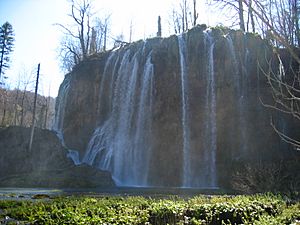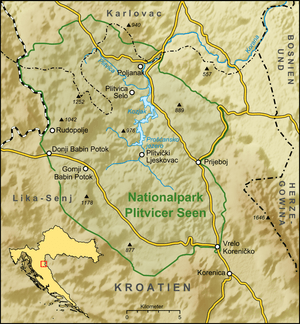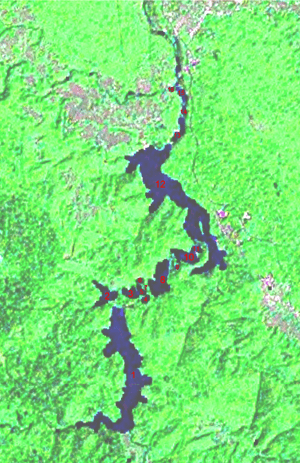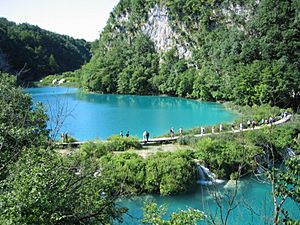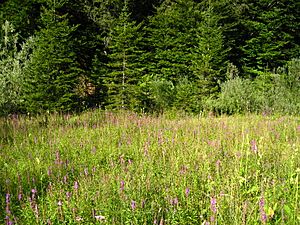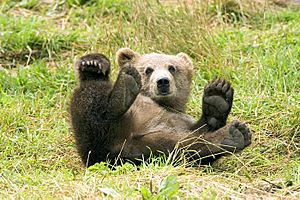Plitvice Lakes National Park facts for kids
Plitvice Lakes National Park is a stunning natural wonder in Croatia. It's famous for its amazing lakes, caves, and waterfalls. These features were created over many years as water flowed over limestone and chalk, leaving behind minerals that formed natural dams.
The park is also home to many wild animals, like bears, wolves, and lots of rare birds. It's the oldest and largest national park in southeast Europe. It was created in 1949 and is located in a mountainous area of central Croatia, near the border with Bosnia and Herzegovina. This area is known as "karst," which means it has lots of caves and underground rivers formed by dissolving rock.
In 1979, Plitvice Lakes became one of the first natural places to be added to the UNESCO World Heritage list, which recognizes places of special importance to the world. Every year, over 900,000 people visit this beautiful park.
The lakes are well-known for their incredible colors, which can be anything from bright blue to green, grey, or even deep blue. These colors are always changing! They depend on how many minerals or tiny living things are in the water, and also on the angle of the sunlight hitting the lakes.
Quick facts for kids Plitvice Lakes National Park |
|
|---|---|
| Nacionalni park Plitvička jezera (Croatian) | |
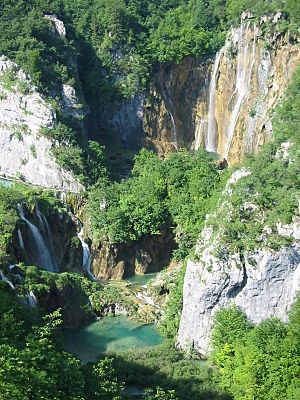
|
|
| Location | Lika-Senj County, Karlovac County, Croatia |
| Area | 296.85 km2 |
| Elevation | 367 m (Korana bridge), 1279 m (Seliški vrh) |
| Visitors | 1,367,304 (in 2015) |
| Governing body | Javna ustanova Nacionalni park Plitvička jezera HR-53231 Plitvička jezera Tel. +385 (0)53 751 015 www.np-plitvicka-jezera.hr |
| Type | Natural |
| Criteria | vii, viii, ix |
| Designated | 1979 (3rd Session) |
| Reference no. | 98 |
| Extensions | 2000 |
| Endangered | 1992–1997 |
|
IUCN Category II (National Park)
|
|
| Type | Natural |
| Designated | 1979 |
| State Party | Croatia |
|
Protected Natural Value of Croatia
|
|
| Official name: Nacionalni park Plitvička jezera | |
| Designated | April 8, 1949 |
| Lua error in Module:Location_map at line 420: attempt to index field 'wikibase' (a nil value). | |
Contents
Plants and Animals of Plitvice Lakes
The Plitvice Lakes area is very important for its wide variety of plants and animals. This is because of its climate and how far away it is from busy, polluted cities and factories. Since there isn't much industry nearby and protective rules were put in place early, the park's landscape has stayed almost untouched. In the old beech and fir forests, rare animals like the brown bear still live.
Amazing Plants of the Park
Plitvice Lakes National Park is mostly covered in forests, mainly with beech, spruce, and fir trees. It has a mix of plants usually found in mountains (Alpine) and those found near the sea (Mediterranean). There are many different types of plant groups because of the varied weather, different soils, and changing heights across the park.
Scientists have found 1,267 different types of plants in the park. About 75 of these are endemic, which means they are found only in this area of the world or nearby. Many of these special plants are protected by law. You can also find 55 different kinds of orchids within the national park.
The huge variety of plants creates a beautiful display of colors that change with each season. The lake area is surrounded by thick forests. The national park covers about 298 square kilometers. Most of this (about 75%) is forest, while about 23% is meadows in village areas, and a small part (less than 1%) is water. A very special part of the park is the Čorkova uvala forest, which is an old-growth forest where some beech and fir trees are up to 700 years old!
Wildlife and Animals in the Park
The national park is home to a huge number of different animals and birds. You can find rare animals like the European brown bear, grey wolf, eagle, owl, Eurasian lynx, European wildcat, and capercaillie. Many more common species also live here.
The wider area around the national park is one of the last places in Europe where you can find a large number of wild brown bears and wolves. The rich animal life of Plitvice Lakes includes about 50 different kinds of mammals. Scientists have also found 321 different types of butterflies, including 76 that fly during the day and 245 that fly at night. They think they've only found about 40% of all the butterflies in the park so far!
There are also 12 types of amphibians (like frogs and salamanders) and several kinds of reptiles. These include lizards like the viviparous lizard and the european green lizard, and snakes like the dice snake and different types of vipers. You can also find the european pond turtle.
When it comes to birds, Plitvice Lakes is one of the top three national parks in Croatia for bird variety. About 157 different bird species have been counted, and 70 of them are known to breed there. The park is also home to many kinds of bats, with about 20 different species found, including the rare Plecotus bat.
Among the original fish species, you can find brown trout (Salmo trutta fario and Salmo trutta lacustris). The Salmo trutta fario is mostly in the Upper Lakes, while Salmo trutta lacustris is mainly in Lake Kozjak. These trout developed differently in the various lakes.
Unfortunately, some fish species that don't belong here (called allochthonous species) have spread quickly. These new species can put the native trout at risk. Besides trout, you can also find common minnows. Some fish like salvelinus alpinus and the North American rainbow trout were brought into this area by people. Recently, even European chub and common rudd have been found, possibly due to climate change. The number of crayfish, which were almost gone, is now growing again. You can even find rare olms (a type of cave salamander) in the underground caves of this region.
Images for kids
-
Small cascades
-
Fish in the crystal-clear water. European chub are driving away trout.
-
Moss covered in calcium carbonate, an early stage of how porous travertine rock forms in Plitvice.
See also
 In Spanish: Parque nacional de los Lagos de Plitvice para niños
In Spanish: Parque nacional de los Lagos de Plitvice para niños



